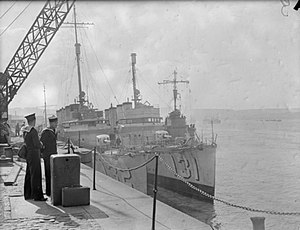
Back Campbeltown (Schiff, 1919) German اچاماس کمبلتاون (آی۴۲) Persian HMS Campbeltown (I42) Finnish HMS Campbeltown (I42) French HMS Campbeltown (I42) Italian キャンベルタウン (駆逐艦) Japanese Hr.Ms. Campbeltown (1919) Dutch HMS Campbeltown (I42) Ukrainian
This article needs additional citations for verification. (September 2011) |
 The newly transferred HMS Campbeltown (right) alongside her sister HMS Castleton
| |
| History | |
|---|---|
| Name | Buchanan |
| Namesake | Franklin Buchanan |
| Builder | Bath Iron Works, Bath, Maine, US |
| Laid down | 29 June 1918 |
| Launched | 2 January 1919 |
| Commissioned | 20 January 1919 |
| Decommissioned | In reserve from 1939 |
| Fate | Transferred to the Royal Navy on 3 September 1940 |
| Name | Campbeltown |
| Namesake | |
| Commissioned | 9 September 1940 |
| Honours and awards |
|
| Fate | Expended on 28 March 1942 in a special operation against the docks at Saint-Nazaire |
| Badge | On a Field White, within an annulet Blue charged in base with a mullet White a sprig of myrtle proper. |
| General characteristics | |
| Class and type | |
| Displacement | 1,260 long tons (1,280 t) |
| Length | 314 ft 4 in (95.81 m) |
| Beam | 30 ft 6 in (9.30 m) |
| Draught |
|
| Installed power | 30,000 shp (22,000 kW) |
| Propulsion |
|
| Speed |
|
| Complement | 158 |
| Armament |
|
HMS Campbeltown was a Town-class destroyer of the Royal Navy during the Second World War. She was originally US destroyer USS Buchanan, and was one of 50 obsolescent U.S. Navy destroyers transferred to the Royal Navy in 1940 as part of the Destroyers for Bases Agreement. Campbeltown became one of the most famous of these ships when she was used in the St Nazaire Raid in 1942.
© MMXXIII Rich X Search. We shall prevail. All rights reserved. Rich X Search